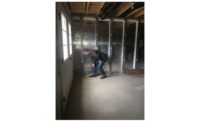Having been in the EIFS business for the past four decades, I get a lot of questions, from homeowners to contractors to architects who want to know more about this wonderful exterior system.
I have been very fortunate to work with many smart people over the years and have always tried to be a sponge, soaking up as much information as possible about the trade that has been so good to my family and me.
My grandfather and great grandfather were old time master plasterers installing lime or putty coat over a sand based plaster, which back in the 40’s had horse hair mixed in. My dad, who also became a master plasterer, was knocking down a whopping 50 cents an hour. My cousins and I used to work for my five uncles or my dad as free labor.
This led me to go to work with Dryvit Systems for six years and then with Circle Supply of the Carolinas for more than 15 years.
I’d like to share some of the things I’ve learned over the years.
Q: What is EIFS and what does it do?
A: According to EIMA, exterior insulation and finish system (pronounced “eefs”) is a non-load bearing, exterior wall cladding system consisting of an insulation board, attached either adhesively or mechanically, or both, to the substrate; an integrally reinforced basecoat; and a textured protective finish coat. To me it’s a lightweight, low maintenance, and beautiful cladding system owners can customize to their desire that will give them many years of service, all the while being very energy efficient.
Q: Why is EIFS so popular?
A: Since 1969 EIFS has been a great insulation system installed on the outside of buildings, providing a beautiful, durable exterior with many textures and an unlimited color selection. In the 1970s when its popularity started to soar, owners realized it is a great way to reduce their heating and cooling costs. A great feature of EIFS is that Expanded Polystyrene (EPS) or Extruded Polystyrene (XPS) foam can be cut or rasped into virtually any profile shape, which means architects and builders love it because they can easily change the “ginger bread” trim and color of each house or commercial building to have its own unique look and feel.
Q: How do I cut EPS and XPS?
A: EPS and XPS are the two most popular foams used in EIFS. Hot knives and hot wire technology are best for cutting or shaping them. I have seen some of the old time plasterers use a sharp steak knife or a straight blade, which results in an awful mess of foam beads all over the job site. I have also seen many nasty cuts with those knives.
Q: How does hot knife and hot wire technology work?
A: EPS and XPS melt at about 450 degrees Fahrenheit. The heated blade or wire melts away the foam and should not come into contact with the EPS and XPS. Once the heat source is removed the melting of foam will stop. One-pound density EPS melts at about 30-inches per minute. Higher heat does not mean you will get greater speed, it does mean the amount of foam melted away is greater.
Q: Is there anything new in hot knife foam cutting technology?
A: For years the hand tool of choice has been a corded, electric hot knife. They are truly workhorses for cutting EPS and XPS boards down to size in the field. However, they’ve always been limited by the need for power cords. Every contractor knows the hassle of dealing with power cords around the job site. Now, after years of design and testing, there is a battery powered, cordless hot knife available. The Carve360 provides hours of operation on one charge, eliminating the need for pesky power cords. Users can literally work anywhere the job requires without restriction.
Q: What about hot wire tables?
A: Like handheld tools, hot wire table technology is ever evolving. Original hot wire tables were large and designed to be used in a production shop environment. Today there are smaller and lighter portable options available that are perfect to take to the job site, allowing EIFS contractors to cut custom shapes on the fly without having to go back to the shop or wait for shapes to be sent from an EPS manufacturer’s location.
Q: Washers or fasteners vs adhesive?
A: While it’s not trendy to wear suspenders and a belt, it’s a surefire way to guard against the dreaded plumber’s crack. Some EIFS manufacturer’s systems are designed to only use adhesive attachment while others are designed for mechanical attachments. Using mechanical fasteners with adhesive is a surefire way to prevent failures.
I believe all contactors would love to attach the EPS/XPS foam, rasp it and get their base coat and mesh installed all in one day. This can be easily accomplished with the addition of a few approved fasteners after the foam panels are adhesively attached. Combining adhesive and mechanical fasteners assures the adhesive will have ample time to cure before rasping and will prevent negative winds from pulling the foam panels away before they are set. Using an adhesive with mechanical fasteners is a guaranteed way to guard against failures that can occur if the EPS/XPS panels are shifted before the adhesive cures.
A word of caution; not all fasteners are alike. Be sure to use a fastener that is third party tested, and approved by your EIFS manufacturer. Using (cheaper) inferior fasteners will result in high failure rates. If you observe fasteners popping off in extreme heat and cold, curling along the outside edge or screws driving straight through the fastener, you know you’re dealing with a cheap imitation that is likely to fail over time.
Q: When attaching EPS/XPS the fasteners sometimes go in too deep. Got a fix?
A: Much like driving screws too deep when installing drywall, EPS/XPS fasteners can also be driven too deep. Fasteners driven too deep can cause a failure in the EIF System by not meeting the wind load it was designed for. An aesthetic issue arises from the thick glob of basecoat that is then needed to fill the void. It will show up through the finish coat and will look horrible for the life of the project. A very easy and inexpensive fix is to use a product such as the Depth Stop 2.0. This simple tool allows you to set the depth of any fastener to any thickness of EPS/XPS with one easy twist.
Q: How do I attach lath?
A: Screws, nails, staples and fasteners are a few methods that we see. Often overlooked when installing lath, self-furring or “dimpled” lath should not be attached too tightly that it is flattened against the wall. The simple solution to this is to use a quality, G90 chromium plated tab washer. They have legs that are designed for the lath to stand off the wall allowing stucco to encapsulate the lath.
Q: How do I get flat walls?
A: Flat foam is critical to a flat EIFS wall. Generally, there are two ways to get flat foam. First, there are hot wire wall skinners that can shave high spots or bellies without the need to rasp them down. The advantage to a wall skinner is minimum EPS/XPS beads floating around the job site. The second, and most common, method is to rasp the wall with a vacuum hand rasp which contains the EPS/XPS beads, keeping them from floating around the job site. Rasps with Tungsten Carbide are the benchmark standard in rasps, outlasting their paper counterparts over 100 to 1.
Stucco contractors will use a darbie of up to 8-feet which helps them provide a nice smooth and level wall. Magnesium is the most popular and most durable choice, with aluminum being a lighter weight option.
Q: How do I fill gaps in the EPS or XPS?
A: This is dictated by the EIFS manufacturer’s recommendation. Some require installers to shim the gap with a sliver of EPS/XPS. This is easily done by cutting a strip of EPS/XPS with a hot knife (battery powered or corded), inserting it in the gap and then sanding down any protrusions with a rasp. Some manufacturers allow the use of expandable spray foams where installers simply fill the gap with the expanding foam, allow it to cure, and then rasp the wall smooth.
Q: What float do I need for my finish?
A: In most cases this comes down to the applicator’s preference. Some specialty finishes may require a specific type of float (neoprene, PVC, sponge etc.). The most important thing to providing a uniform texture is that everyone floating a wall uses the same hand motion in the same direction as well as the exact same float. There are specialty floats available like bamboo and texture pattern floats. Many “old school” plasterers opt for a stainless steel trowel. The golden rule is that everyone uses the same float and same direction to keep the texture uniform and consistent.
Q: How to protect windows, doors, and tools from EIFS and Stucco?
A: Everyone knows the pain and high cost that comes from getting EIFS finish and basecoat off a window, doorframe or roof shingles. For the most part good preparation is the best thing you can do. 60-day tape, while not cheap, will perform great under long UV exposure. It aggressively sticks to most surfaces without leaving a sticky residue to clean up and will also come off without shredding apart causing you to spend hours pulling strands off. Blue window film is a huge labor saver because it protects window glass from overspray. When the job is done just peel it off and the glass is as good as new.
In the case of overspray or a spill there are various strengths of cleaners, from the gentle strengths that will not damage painted or anodized finishes, to the more powerful cleaners that remove EIFS from brick, concrete and wood. For stucco there are acid free products that will remove hardened stucco off of tools and mixers. There are chemical products available to remove tar that has seeped over the edge of a roof onto the wall, or remove the graffiti markings of those creative souls who have too much time on their hands.
Q: What is the future of EIFS?
A: Unlimited—unless we screw it up. To those of us who have been involved with EIFS for several decades, we recall the growing pains like rust in the finish, fire testing questions, mesh leaching through the finish and moisture concerns …we cannot afford to have any more slip ups with this wonderful system. Follow the EIFS manufacturer’s instructions, use quality tools and continue to educate yourself and your staff by attending an EIMA Doing-It-Right seminar. Take pride in our industry and it will take care of
you. Keep on troweling.










Report Abusive Comment